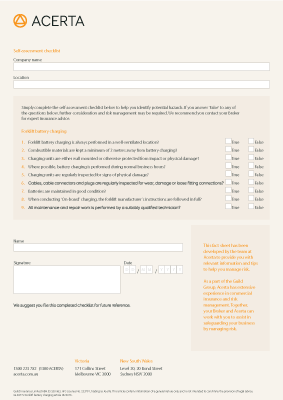
Forklift Battery Charging
During forklift battery charging volatile gases are released which can create an explosive, flammable gas atmosphere. This gas, if allowed to accumulate, can be easily ignited, resulting in a significant property loss.
The gases produced during battery charging include flammable Hydrogen, and Oxygen. Whilst oxygen is not flammable it is a vital component in the process of combustion. In the presence of an ignition source, such as an electrical spark, explosive ignition
and fire are likely to occur. By its nature, battery charging processes are prone to having electrical ignition sources present.
Experience shows us that many serious fire losses can be avoided. We have used our industry knowledge and claims experience to produce this easy to follow guide and self-assessment checklist.
Following are some helpful hints to help you avoid fires caused by forklift battery charging:
Location
- Battery charging should be conducted in an open area with adequate natural ventilation.
- In confined spaces, consideration should be given to the installation of mechanical ventilation.
- Combustible materials should be kept well away from the charging area.
- Floor markings should be used to ensure a clear space of 2-3 metres is maintained around the charging unit at all times.
- Wall mounting of the charging unit will help to protect it from physical damage.
- Where possible, conduct battery charging during work hours.
Maintenance
- Regularly inspect the charging unit for signs of physical damage.
- Inspect all cables for wear or damage to the insulation.
- Ensure cables lay straight during charging and do not have kinks or knots in them.
- Replace damaged cables, do not use electrical tape to cover worn or cut insulation.
- Inspect all cable connectors and plugs, ensure they are not damaged or loose fitting.
- Ensure that the batteries are in good condition, have adequate fluid levels and the contact points are clean.
- When conducting ‘On-board’ charging, ensure the forklift manufacturer’s instructions are followed in full.
- All maintenance and repair work must be performed by a suitably qualified technician.
- Ensure that the forklift and charging equipment are regularly serviced by suitably qualified technicians
Download your self-assessment here

